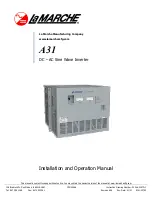
1-8
INTRODUCTION ORBAN
MODEL
1010
Mixing Facilities:
In addition to sound card and audio processing functionality, Optimod-PC is also a
capable mixer, having one stereo analog input, two AES3 / SPDIF digital inputs
(which can accept any sample rate from 32 to 96 kHz), and one WAVE input (to ac-
cept Windows sound sources), all of which can be mixed. Thanks to onboard sample
rate converters, the two digital inputs can accept and mix asynchronous sources,
which may have different sample rates. In practice, the four inputs might be used
for a local feed, a network feed, a voice channel, and a wave player, making Opti-
mod-PC the heart of a “desktop netcasting studio.” In many cases, this versatility
allows you to avoid use of an external mixing desk, thereby keeping the audio path
100% digital. The wave player could be any one of a number of broadcast-oriented
automated playout systems.
Using Optimod-PC’s separate “processed” and “unprocessed” mixers, any of the in-
puts in any combination can be processed or passed directly to the input of Optico-
dec-PC without processing—you can always choose how much processing (if any) to
apply to the audio. These features allow local program insertion, such as those re-
quired in order to address the broadcast rights issues of many commercials, pro-
grams, and events.
Because it uses Microsoft DirectSound Drivers, Optimod-PC is able to play multiple
audio streams from multiple audio sources, eliminating the need for multiple or
multi-channel sound devices for professional playout systems used in automation
mode. Given the CPUs available today, MPEG1 Layer 2, and/or Layer 3 decoding can
occur at the operating system level, eliminating the requirement for expensive
hardware-based MPEG decoder sound devices.
Encoding
Opticodec-PC receives the output of Optimod-PC, which looks like a sound card to
the operating system. Opticodec-PC then reduces the bitrate of the processed signal
by applying it to an AAC or aacPlus perceptual coder and packetizing the resulting
data for an Ethernet network. When the encoder connects to the streaming server,
the encoder generates the Session Description Protocol file and transfers it auto-
matically to the streaming server.
The most basic use of Opticodec-PC is to create a single stream at a single bitrate.
However, the output of a given Optimod-PC card can feed several Opticodec-PC en-
coders running at different bitrates to service different audience bandwidths; all of
these streams will carry the same audio program.
If you need more than one audio program stream, use multiple Optimod-PC cards
(some of which can be housed in one or more PCI expansion chassis). If you need
multiple streams at different bitrates, configure each Optimod-PC card to feed its
own array of Opticodec-PC PE encoders.
Each installation of Opticodec-PC PE is keyed to one Optimod-PC card, so
running more than one audio program stream requires one Opticodec-PC
PE installation per audio program stream even if all of these installations
are on one computer. However, a single Opticodec-PC installation can
create multiple streams at different bitrates if all of these streams contain
the same audio program.















































